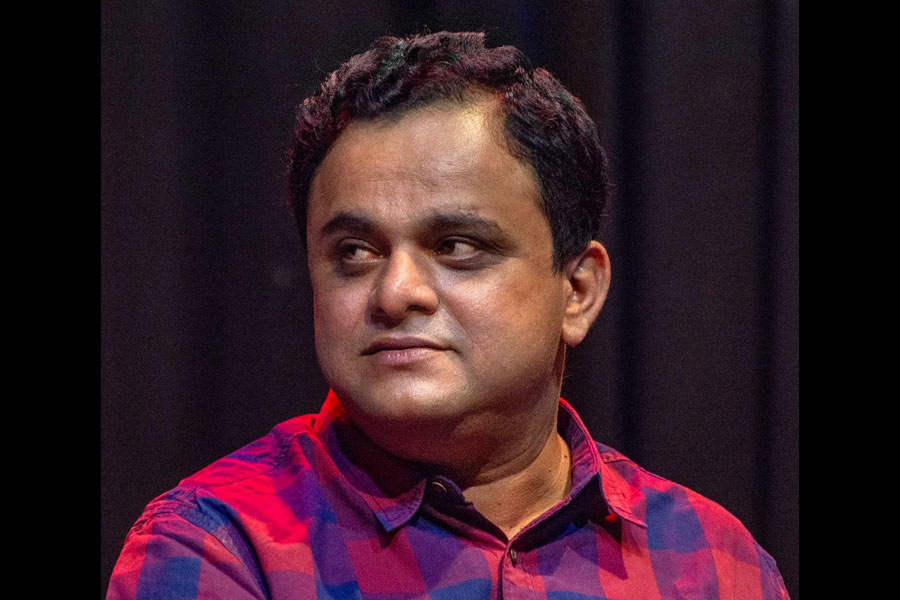 |
| Rohan Joshi, who is a half-Gujarati and half-Maharashtrian, pokes fun at both communities on the stage Pix: Gajajnan Dudhalkar |
Stand-up comedian Tanmay Bhat, 24, was always the class clown in college and loved to keep everyone around him in splits. Still he never thought that getting a laugh out of people would become his calling. But after winning the Weirdass Ham-ateur Night in 2009 in Mumbai (a national comic hunt launched by ace comedian Vir Das) Bhat’s been criss-crossing the country doing gigs in pubs and all kinds of other venues. “The greatest high for me is when I have the audience in peals of laughter,” says Bhat, who has done more than 100 stand-up shows.
Cut to Rohan Joshi, 28, who’s a half- Gujarati and half-Maharashtrian and takes potshots at both communities on stage. “As a half-Gujarati, I apologise for the existence of Himesh Reshammiya,” cracks Joshi. But he also keeps the audience amused aiming his barbs at everything from, “the circus around the British royal wedding this year to Baba Ramdev to President Obama’s Mumbai visit”. He describes himself as “a stand-up comedian who loves to write but hates bad grammar and SMS language”.
 |
| His flair for comedy made Raghav Mandava choose stand-up over bartending and journalism |
Once upon a time it was said that Indians didn’t have a sense of humour. But now young Indian audiences bred on the international comedy of maestros like Jerry Seinfeld and Chris Rock are turning up in huge numbers to watch home-grown English stand-up comedy.
You could argue that stand-up comedy is nothing new to India and bring up names likes Johnny Lever and Sunil Pal who could hold audiences spellbound with their non-stop mimicry. But the genre of English stand-up comedy is a new niche that’s only now gaining acceptance.
Bhat and Joshi belong to the new generation of funny men who are changing the face of English stand-up comedy in India. Says Kunal Rao, owner of the online comedy club The Yellow L: “English stand-up comedy is all about telling a narrative yet keeping the humour quotient alive.”
 |
| Praveen Kumar has a group called Polished Bottoms alongwith three other comedians in Bengaluru |
So what started as a trickle with ace comedians Vir Das and Cyrus Broacha a couple of years ago is now a full-time industry with a mini-army of Seinfelds looking out for laughs all the time.
Take a look at playwright turned stand-up comedian Anuvab Pal whose foray into stand-up comedy was, as he puts it, “purely accidental”. Pal lived in the US for some years and wrote scripts of the hugely popular sitcoms Frasier and also Law & Order. Closer home he helped to raise laughs as a screenplay writer of Loins of Punjab Presents and The President is Coming.
Pal is also a playwright and the creator of plays like Chaos Theory, Fatwa, and Life, Love and EBITDA. He emphasises that comedians have to move with the times and audiences. “Jokes have gone out-of-fashion and my focus is mainly on telling stories with material people can relate to. I don’t work on one-liners but my acts are laced with anecdotes,” he says.
 |
| Anuvab Pal wrote the screenplay of films like Loins of Punjab Presents and The President is Coming Pix: Gajajnan Dudhalkar |
Pal who performs regularly at The Comedy Store, which set up shop in Mumbai last year as a venue for stand-up acts, however, steers clear of performing in restaurants. “I feel it is an intrusion into their private space because people go to a restaurant to enjoy their grilled chicken and not to listen to stand-up comedy,” he says, laughing.
There are others like 26-year-old Ashish Shakya who points out sharply that if you can’t be funny in two-minutes you cannot be funny even in 20 minutes. Shakya took to comedy writing while still studying engineering in Mumbai. Today, he’s already done 50 stand-up shows and is a co-writer of the news-based comedy show The Week That Wasn’t with Cyrus Broacha on CNN-IBN.
 |
| Tanmay Bhat came into the limelight after winning a national comic hunt in 2009 Pix: Gajajnan Dudhalkar |
One big reason for the growth of English stand-up comedy is the increase in the number of venues like nightclubs, pubs and even auditoriums where comedians can prove their worth. For instance, there’s UK-based The Comedy Store. In Mumbai, The Comedy Store is thinking local. Says Don Ward, CEO of The Comedy Store: “Indians have a good sense of humour and a lot of people here are English-speaking so the genre has great potential. I want to give a platform to more local heroes.” Ward is keen to take The Comedy Store in Chennai, Bengaluru, Delhi and Calcutta.
Different types of shows are being tried out by these comedians and the clubs. There’s the Open-Mic Nights started by veteran comedian Papa CJ in 2009. Here anyone can take the stage to hone their comic skills. Then there’s Vir Das who started his hugely popular show, Ham-ateur Nights, which is also a platform for fresh talent. There’s also Improv comedy in which improvisation is the name of the game. “There’s no script but comedians make up funny stuff taking ideas from the audience,” says Rao.
 |
| Ashish Shakya is a co-writer of a news-based TV comedy show hosted by Cyrus Broacha photograph courtesy The comedy store, mum |
Even women are getting into the stand-up comedy game. Take 24-year-old Aditi Mittal, who wears many hats as an actress, voice-over artiste and a stand-up comedian. But she says its live shows that give her the greatest kick. She has appeared on Jay Hind India’s first online stand-up show with Sumeet Raghavan and was a regular on Phenking News with Cyrus Broacha on CNN-IBN. Says Mittal: “I’m half-Punjabi and half-Sindhi and so comedy runs in my blood.” But she acknowledges that it’s not easy to be a woman stand-up comedian. “A lot of my acts stem from women’s harassment in public spaces and the weird things women are subjected to,” she says.
But what is it that makes Indians laugh? Inevitably, these young comedians take aim in all directions. Mittal finds humour in everything from Anna Hazare to pop culture to reality TV shows. At a slightly different level, Bhat’s humour is what he calls “a mix of topical and observational”.
Pal focuses on a deadpan approach to storytelling, “You can be funny even with a straight face and needn’t resort to funny expressions. My humour comes from stories about growing up in the ’80s and I contrast it with that of contemporary India like for instance how customs officers and the so-called smugglers of the ’80s have changed today.”
Meanwhile, Shakya does comedy sketches (these are one or two-minute comedy skits or monologues exploring a concept or a character). “I love telling funny stories about the idiosyncrasies of various Indian communities,” he says.
 |
| Apart from doing stand-up, Aditi Mittal also wears many hats as an actress, comedy writer and voice-over artiste Pix: Gajajnan Dudhalkar |
And it’s not just Mumbai alone that is getting its share of laughs. Delhi-based Raghav Mandava, 24, who launched his company Cheese Monkey Mafia last year, is ensuring that there are more comedy shows in Delhi. “The road ahead is to get more venues and also to improve the quality of the acts,” he says. Though he doesn’t want to limit his comedy style, he loves being an observational comic. Mandava who’s a certified bartender and a journalist shifted full-time to stand-time comedy inspired by Papa CJ.
On the other hand, Bengaluru-based Praveen Kumar, 30, along with funnymen Sal Yusuf, Sanjay Manaktala and Sundeep Rao have formed a group called The Polished Bottoms. They give their funny take on everything under the sun — from Bollywood to Bengaluru’s chaotic traffic to Rakhi Sawant and even IPL. But Kumar points out that Indians can still be touchy — and even a bit scared of comedians. “People are even scared to sit in the front row because they think comedians will pick on the first row,” he says.
It goes without saying that being funny is a serious business and careful preparation is essential before every performance. “You need to jot down everything you see. I carry a recorder in my bag and record random words or sentences I hear,” says Mittal.
Joshi too keeps his eyes and ears open and does thorough homework before any show. He says: “The ability to talk non-stop in front of a huge audience is daunting and one has to know what he is talking about.” While Joshi puts an emphasis on comic timing and proper breath control, Pal’s mind is always racing about, “when to engage and when to disengage the audience.”
One crucial skill for a comedian is to know how to win over tough challenges. A silent crowd and obnoxious behaviour are some of the speed-breakers that they’ve all faced. Bhat and Shakya faced such a situation some time back when they went to do a corporate gig at a five-star hotel in Mumbai. Says Bhat: “The audience was a mix of African and Asian and didn’t know English. We tried our best to make them laugh but nobody laughed. Frankly, it was emotionally scarring for both of us.”
And, of course, every funnyman must be able to deal with hecklers. Says Kumar: “An adept stand-up comedian is one who can tactfully silence a heckler and win over the crowd.”
But what do the comedians get out of this tough business — apart from the laughs? Established stand-up comedians get anywhere around a lakh per show and the newer ones in the game can pick up about Rs 30,000 per performance.
Certainly, the genre is exploding and new avenues are opening up. Bhat and Joshi, for instance, work as comedy consultants. They have worked on the comedy scripts for reality shows and even Filmfare Awards. Pal too has his hands full with writing assignments — a mainstream comedy film, a new play and two book projects. He also teaches comedy writing at the Film and Television Institute of India, Pune, and at Whistling Woods, Mumbai.
So what are the dos and don’ts of English stand-up comedy? Ward says that comedians must be ready to push the barriers all the time. “If you play safe, it tends to become boring,” he says, emphasising the fact that comedy can be a tough way to earn a living. But that doesn’t seem to be stopping many young men and women who’ve made it their career goal to make people laugh.










